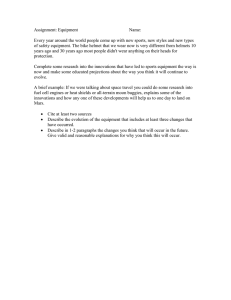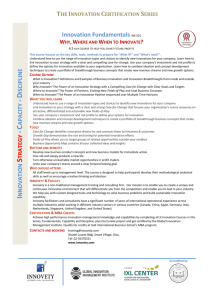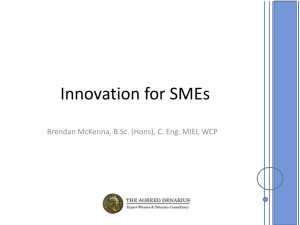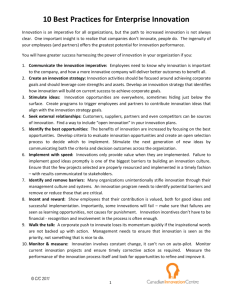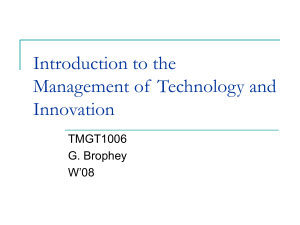15.352 Many users innovate – and
advertisement
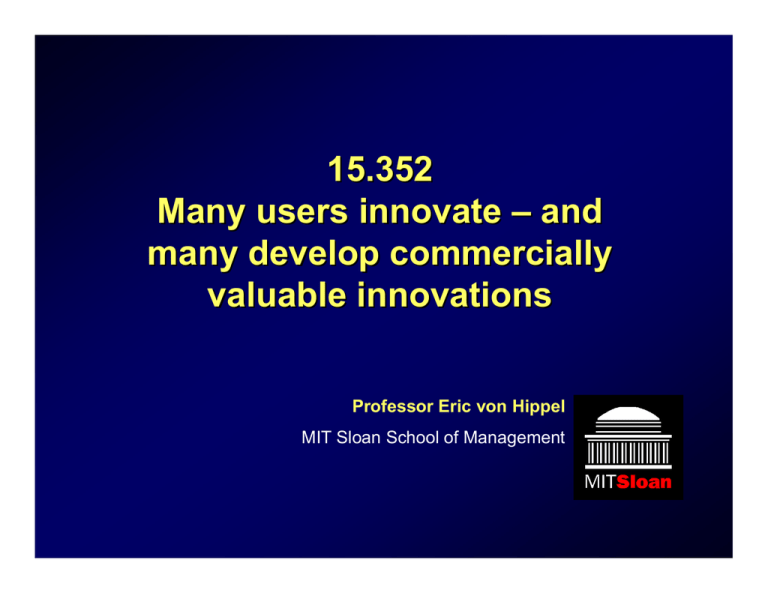
15.352 Many users innovate – and many develop commercially valuable innovations Professor Eric von Hippel MIT Sloan School of Management Essential Definitions The “functional” source of innovation depends upon the functional relationship between innovator and innovation: – An INNOVATION is anything new that is actually used (“enters the marketplace”) – whether major or minor. – An innovation is a USER innovation when the developer expects to benefit by USING it; – An innovation is a MANUFACTURER innovation when the developer expects to benefit by SELLING it. Major finding: many users innovate Industrial products n % innovating Printed Circuit CAD 136 24.3% Pipe Hanger Hardware 74 36% Library IT Systems 102 26% Software security features 131 19.1% Surgical Equipment 262 22% Consumer products n % innovating Outdoor Products 153 9.8% “Extreme” sports equipment 197 37.8% Mountain biking equipment 291 19.2% WHY do so many users want custom products? Because many have “custom” needs. z Two analyses of published market segmentation studies (done by cluster analysis) show that about markets are typically divided into about 5 segments, and 50% of total variation in need is within-segment variation. z This means that when manufacturers divide a market into a few segments, many are dissatisfied by the products on offer – some seriously so. Luxury focus “Sporty” auto Driving focus Car buyers with a reliabilty and safety focus WHY do so many users want custom products? Because many have “custom” needs. z Let’s test this statement against your personal experience. z Discuss 3 items in turn: 1. What product type do you care most passionately about? 2. What shortcomings does the specific product of that type you bought (built?) have in your view? 3. Do you think a lot of other people have the same unmet need as you do? Or are your needs pretty “custom?” Why are your needs so special? Innovating users tend to develop commercially valuable products - because they tend to be “lead users” Lead Users are users that: 1. Have needs that foreshadow general demand in the marketplace; 2. Expect to obtain high benefit from a solution to their needs. (Such users are more likely to innovate – “Necessity is the mother of invention!”) “Lead User” innovations offer the basis for new products and services of value to manufacturers. Lead Users are today facing target market “emerging needs” Only lead user prototypes available Commercial versions of product available # of users perceiving need Target Market Time Time In PC-CAD Lead Users were innovating Routine Users were not Expected Lead Type of Questions We User Attribute Asked At Front of What are your: “High Density” z Avg. Number of layers? Trend? z Avg. Line width (mils)? (1988 data) High Need For “Are you satisfied with your Improved present PCB CAD system? System? Active In Did you build own PCB Solving Own CAD System Problem? Number in Sample LEAD Users Routine Users 6.8 11 4.1 15 No It’s OK 82% Yes 1% Yes 33 99 User innovation has been shown to be the source of prototypes for many “manufacturer” product successes Innovations Affecting First Device Major Improvement Minor Improvement Gas Chromatography 1 11 - Nuclear Magnetic Resonance Spectrometry 1 14 - Ultraviolet Spectrophotometry 1 5 - Transmission Electron Microscopy 1 14 63 Total 4 44 63 First device used in field developed and built by: Innovations Affecting % User User Mfg. Gas Chromatography 83% 10 2 Nuclear Magnetic Resonance Spectrometry 80% 12 3 Ultraviolet Spectrophotometry 100% 6 0 Transmission Electron Microscopy 72% 44 17 Total 77% 72 22 The World Wide Web – A Lead User Innovation “Tim Berners-Lee did not set out to invent a contemporary cultural phenomenon; rather, he says, “it was something I needed in my work.” He wanted to simply to solve a problem that was hindering his efforts as a consulting software engineer at CERN. Berners-Lee’s innovation was to apply hypertext to the growing reality of networked computers. He expanded the idea he had developed at CERN and made it available on the Internet in the summer of 1991. Technology Review, July 1996, p.34 Many commercially important consumer products also have roots in user innovation. Familiar product examples: Category Example Health Products Gatorade Personal Care Protein-base Shampoo Feminine Hygiene Sports Equipment Mountain Bike Skateboard Scuba gear Apparel Sports Bra Food Chocolate Milk Graham Cracker Crust Office White-out Liquid Software Electronic Mail, Desk Top Publishing User-innovators in consumer fields are lead users too – sports equipment example Sports equipment user Characteristics Innovators NONinnovators Difference 4.29 5.84 p<0.001 “I have new needs which are not satisfied by existing products.” 3.27 4.38 p<0.001 “I am not satisfied with existing equipment.“ 3.90 5.13 p<0.001 Lead User Characteristic (1): Being Ahead of the Trend * “I improved or developed new techniques in my sport.” Lead User Characteristic (2): High Benefit from Innovation * Data source: Sports equipment study: Franke and Shah (2003) *7-point rating scale: 1 = very accurate; 7 = not accurate at all Users tend to innovate at the leading edge of markets – where demand is small and uncertain. SO - lead user innovations can become the basis of commercially valuable products for manufacturers Users can innovate more cheaply here (finding with Carliss Baldwin) Manufacturers can innovate more cheaply here # of users perceiving need Time In sum: Many users innovate because they have custom needs – the products they develop are valuable to manufacturers because innovators also tend to be “lead users:” z Innovations developed by lead users have high commercial value – Morrison and several other authors z Commercial value of innovations users develop goes up as “lead user” characteristics of innovators intensify – Franke & vH

